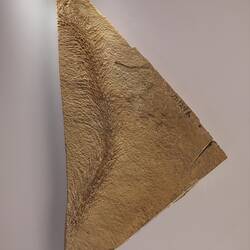Baragwanathia longifolia is a fossil club-moss from Victoria. It was very important in the history of our understanding of the evolution of land plants.
Dr. Isabel Cookson described
Baragwanathia longifolia while working on the fossil plants of Victoria in the 1930s . She named the genus after William Baragwanath who was the director of the Geological Survey of Victoria at the time and had collected many of the specimens she worked on.
Baragwanathia fossils are usually found as pieces of stem between 10 and 50 cm in length with long narrow leaves arranged in spirals around the stem. The stems are often only visible as iron-stained impressions in rocks. When it was alive
Baragwanathia would have looked very similar to its modern relatives, club-mosses and tassel-ferns, but was much larger, growing up to 2 m long with a sprawling form.
Baragwanathia was a vascular plant, meaning that it had an elaborate structure of strong internal tubes (the vascular system) for transporting water, nutrients and gases in sap and for supporting itself. Most plants that were alive at the same time were much less complex than
Baragwanathia and were small stems without leaves.
Baragwanathia's structure allowed it to survive on land though it would have grown in swampy areas.
Baragwanathia longifolia is known from multiple locations through central Victoria and occurs with many other plant and animal fossils. The combination of plants is called the
Baragwanathia flora and it occurs in Victoria in rocks of two different ages, late Silurian (about 425 million years old) and Early Devonian (about 410 million years old).
Baragwanathia is much more advanced than any other vascular plants known from the late Silurian. In 1937, shortly after the original description of
Baragwanathia, William Henry Lang described a genus of more primitive, leafless vascular plants from the Devonian he called
Cooksonia after Isobel Cookson to recognise her ground-breaking work. In 1980 a new species of
Cooksonia from Ireland was described that had been found in middle Silurian rocks, making it around 2 million years older than
Baragwanathia.
The site at Yea, Victoria from which many specimens or
Baragwanathia were collected was discovered in 1875 but the scientific importance of the site and the fossils wasn't understood until Cookson's work in the 1930s. The Yea Flora Fossil Site has been included on the Australian National Heritage List since 2007 in recognition of the international significance of the fossils and their contribution to our understanding of the early evolution of land plants.
The
Baragwanathia flora probably dominated the coastal regions of south eastern Australia for up to 15 million years, and other species of the genus are also now known from fossil sites around the world.
Baragwanathia longifolia was one of eight candidates for Victoria's fossil emblem in 2021. In January 2022
Koolasuchus cleelandi was announced as the new Victorian fossil emblem.

